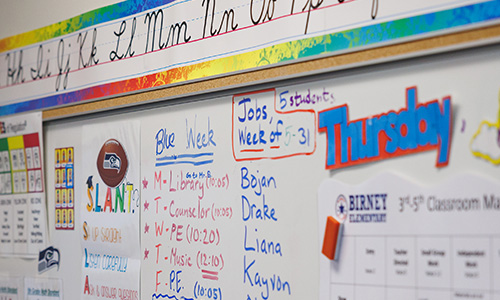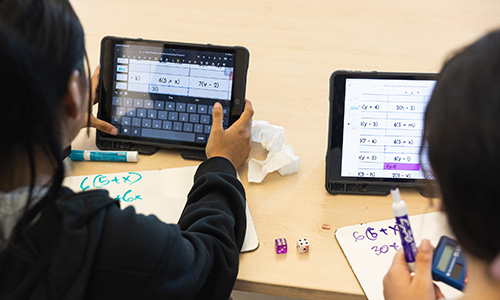
I’ve been a champion of the importance of writing in math class for a long time.
My first classroom position was teaching sixth-grade science at an elementary school. I had a great curriculum with a lot of hands-on exploration of phenomena that both my students and I loved. The one thing missing, though, was a real reading and writing component. So, I created an introductory unit on science writing. It involved teaching students explicitly how to make and record detailed observations and clearly explain the rationale for their inferences. I worked with the school librarian to get access to age-appropriate science magazines and had students read and respond to articles regularly. As someone who loves to write, it made sense to me to incorporate writing into all areas of the classroom.
I brought this interest in content-area writing along when I transitioned to teaching third grade. That curriculum had plenty of opportunities to write in science and social studies. However, I noticed that beyond the typical “Explain how you solved the problem” prompts, there was very little writing in math. When I excitedly asked my new grade-level colleagues if they used math journals, they looked at me as if I had spoken to them in another language. The idea of writing in math seemed somewhere between unnecessary and ridiculous to them.
Thankfully, teachers have become much more open to writing in math class since then. NCTM’s 2000 publication “Principles and standards for school mathematics” helped drive this connection by including communication as a key component of mathematics learning. NCTM framed mathematical communication as “a way of sharing ideas and clarifying understanding. Through communication, ideas become objects of reflection, refinement, discussion, and amendment. When students are challenged to communicate the results of their thinking to others orally or in writing, they learn to be clear, convincing, and precise in their use of mathematical language.” Since this publication, most college-and-career ready standards have incorporated the need to communicate mathematical ideas into their math practice standards.
Why is writing in math class important?
The act of writing involves examining, organizing, reconsidering, and synthesizing one’s ideas. Writing is a “knowledge transforming” process that involves both the retrieval and encoding of ideas and concepts in our memory. As stated in the NWEA stances on writing, “Writing is a cognitive, nonlinear process that serves as a tool for learning and critical thinking, stimulating the writer to think more deeply about a text, topic, or concept. In this way, writing doesn’t just show thinking; it is thinking, and it is an essential practice across disciplines.”
Research has demonstrated the impact of writing in furthering mathematical understanding. A 2020 meta-analysis of research on writing in the content areas of math, science, and social studies showed that writing to learn in each of these subject areas “reliably enhanced learning” with an effect size of 0.30. Another meta-analysis focused on writing specifically in math found an even greater effect size of 0.42.
Writing in math class can both uncover and potentially improve students’ attitudes toward the subject. A 2014 study involving students with high math anxiety found that when students wrote expressively about their thoughts and feelings prior to an exam, the difference in performance between low and high math anxiety students was significantly reduced relative to the control group in which students did not engage in pretest expressive writing.
There’s more than one write way
At a high level, there are two different ways to think about writing in the math classroom. One way is a writing-first approach, where the focus is on improving student writing, and math is a topic that is used to support this. The other approach is math-first, where writing serves as a tool for helping students learn and integrate mathematical content.
Naturally, with a writing-first approach there is more emphasis on drafting, revising, and honing writing. In a math-first approach, which will be the focus of this article, revisions are less common. While students should be taught and coached on how to articulate mathematical ideas and arguments clearly, revisions are more about recording shifts in students’ thinking about the mathematical content than they are about mechanics or style.
Within the math-first approach, there are many ways to incorporate writing in math class. I’ll dig into four of them here.
1. Eliciting impactful explanations
Let’s start by examining the aforementioned “Explain how you solved the problem” prompts found in many teaching materials.
You are likely familiar with the tepid and uninformative responses these questions can elicit if students are not taught how to unpack their mathematical thinking. Without coaching and modeling, students are likely to simply list the series of steps they took to solve the problem, rather than explain why they chose that approach, identify challenges they encountered and decisions they made along the way, and say how they determined their answer was reasonable. Just as I had done when teaching science, I realized I needed to explicitly teach my students to explain how they approached and solved a problem. This instruction went hand in hand with developing a classroom culture where students felt comfortable explaining their thinking orally, asking and answering questions of one another, and defending their mathematical thinking.
To start, when solving a problem, I would model my own mathematical thinking on chart paper. I did this in a double journal entry style, solving part of the problem on one side of the paper and then recording my thoughts and decisions on the other side. Capturing decisions, missteps, mistakes, and course changes is a great way to model the math practices, particularly making sense and persevering in problem-solving. It is also a great way to model that the problem-solving process may not always be linear and that mistakes are normal and can lead to deeper understanding.
Writing in math class can both uncover and potentially improve students’ attitudes toward the subject.
After I finished, I would allow students to ask questions about what I wrote and I would use this to add to my writing, or I would annotate what to include next time. As students started writing on their own, I would share less-than-exemplary examples that I had created, alongside high-quality student examples. First as a whole class and then later in pairs, students would highlight the differences between the pieces and we would annotate the poor examples to show how to improve them. This included sharpening mathematical vocabulary, discussing models that could support the written text, and adding details for clarity. Finally, as students gained more confidence in their writing, I would pair students who solved the same problem using different approaches. The students would read each other’s explanation and then ask questions to help clarify the other student’s writing. Because these were not formal writing pieces, students didn’t necessarily need to rewrite their explanations; however, they at least needed to take notes of what might help make their explanations clearer next time.
The power of connecting writing and problem-solving was well summed up by the authors of “Aiming for understanding: Lessons learned about writing in mathematics”: “Writing during problem-solving instruction was introduced to help us assess our students’ thinking, but…we concluded that writing about problem solving and reading others’ thoughts…actually helped our students develop a deeper understanding of the problem-solving process. What began as an assessment tool was now being recognized as an instructional tool. We were beginning to view writing as integral to the teaching of mathematics concepts.”
2. Providing a formative foundation
Mathematical writing can be a rich vehicle for formative assessment, and it can be employed before, during, or after a lesson or unit. For example, before starting a unit on fraction addition, you might assign a 5–10 minute quick write in which students record everything they know about fractions. Reviewing the writing can give you more insight into student understanding than a quiz, which is inherently limited in terms of content included. The knowledge you uncover about your students can help you tailor interventions and small- and large-group lessons to where students are in their conceptual understanding of fractions. The process of recall leverages spaced retrieval practice, which helps with long-term retention of information. Recalling related past concepts also primes students to connect previous content to new content, a topic I’ll discuss in the next section.
During the lesson, you can convert the traditional “Think, Pair, Share” activity into a “Think, Write, Pair, Share” activity. The writing can be done either on individual whiteboards or in a notebook, if you’d like to save the students’ writing. Adding writing to this protocol can give students more time to process their thinking. Additionally, if the writing is recorded in a journal, later in the unit students can be asked to reread earlier entries to reflect on how their thinking has changed or deepened.
Finally, end-of-lesson quick writes where students record the three most important things they learned, identify and define key vocabulary in their words, or comment on a particular student’s explanation or response can serve both as an assessment of student learning and a way for students to synthesize their new knowledge.
3. Making connections
Despite how many of us were taught it, mathematics is all about connections. Connections, along with communication, is one of NCTM’s five process standards. Students at all levels should be able to recognize and “understand how mathematical ideas interconnect and build on one another to produce a coherent whole” as well as how they connect to the wider world. I discussed why making connections is so critical in “Maximum impact: 3 ways to make the most of supplemental content.” Math journals and writing prompts are a great way to have students look for connections among concepts.
Varying degrees of scaffolding can be used to help students make connections. You can directly ask them to do a quick write that compares two concepts, such as multiplying whole numbers and multiplying a fraction and a whole number. Or, prior to starting a new unit, students could be asked to write down everything they know about a concept related to the upcoming unit. For example, if students are starting a unit on multiplication, you can ask them to write everything they recall about arrays. As you move through the unit, you can ask questions to explicitly help them see the connection between arrays and multiplication.
You also want to provide prompts that allow students to find their own connections between concepts. Having students create concept maps is a great way to have them show connections between concepts. Simple sentence starters or sentence frames like “Division reminds me of…” or “Volume is similar to ______ because ______. Volume is different from ______ because ______” give students the freedom to make their own connections. In their article about improving writing prompts in mathematics, authors Craig Sjoberg, David Slavit, and Terry Coon share a simple three-part prompt to help students make mathematical connections:
- Explain at least one thing you learned in math this week.
- How does your answer connect to other mathematical ideas?
- How do these ideas connect to the real world?
4. Supporting metacognition
In addition to all the ways to have students share their mathematical understanding, I also liked to use math journals as a means of reflection. Students can be prompted to consider how they engaged with an activity or a discussion, reflecting on what helped to move their thinking along, what may have confused them, and more. This can help them understand how they learn best.
Metacognition, or the awareness and regulation of your own thought processes, is a key component to creative problem solving (as opposed to rote following of procedures). There are several ways to incorporate this type of reflection into math class:
During a lesson
If you have students take notes in class, you can teach them to engage in note-taking/note-making activities where they write the main idea on one side of the paper and their thoughts, reactions, and connections on the other side of the paper.
After a lesson
Have students respond to one of the following prompts:
- Did you have any lightbulb moments during that lesson? What led to that moment?
- Is there anything that is still confusing to you?
- What did you know or think about this topic before today? How has your understanding changed?
- How might you have presented this topic to someone else?
- Did you need more time to work today? Was the activity too long or just right?
At the end of the week or at the end of the unit
Ask students to reflect on specific activities, lessons, or conversations they engaged in:
- Which one was the most interesting to you?
- Which one helped you understand something better? What did it help you understand better and why?
- Which one changed your thinking about a mathematical idea?
- Did any confuse you or leave you with new questions?
The wide world of mathematical writing
I have touched on only a few ways to think about writing in math class. Thankfully, there is an abundance of resources to help you explore a wide variety of ways to get your students writing about math. Here are just a few of them.
- “5 ways to use writing in the disciplines to support learning” This Learn. Grow. Post delves into ways to infuse writing in all content areas.
- “Writing in math” This article by Marilyn Burns provides examples of how to integrate writing in math class.
- Using writing in mathematics to deepen student learning This guide discusses the research supporting writing in math, explores different approaches to math writing, and provides prompts and samples of student writing.
- “8 ways to pose better questions in math class” Although the focus of this article isn’t strictly on writing, the tips and prompts provided can be applied to writing.
- “Integrating writing and mathematics” This Reading Rockets article shares multiple strategies and examples of student writing in math class.
- “Write on” This NCTM article discusses four categories of mathematical writing and provides prompts for each type.
- “Talking, writing, and reasoning: Making thinking visible with math journals” This Read Write Think lesson models how to incorporate journals into math activities and includes prompts designed to uncover students’ attitudes and dispositions toward math.
- “Journal prompts for elementary students” This resource contains three pages of math writing prompts.







